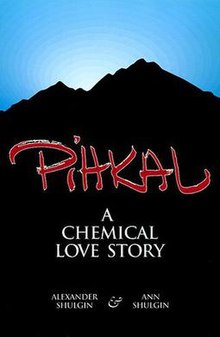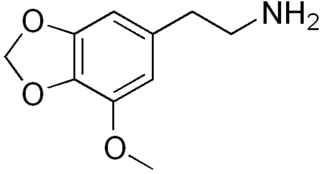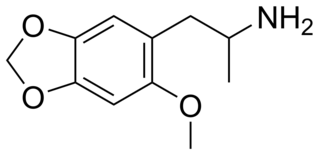| Substance | Chemical name |
|---|
| 1 | AEM | alpha-Ethyl-3,4,5-trimethoxy-PEA |
| 2 | AL | 4-Allyloxy-3,5-dimethoxy-PEA |
| 3 | ALEPH | 4-Methylthio-2,5-dimethoxy-A |
| 4 | ALEPH-2 | 4-Ethylthio-2,5-dimethoxy-A |
| 5 | ALEPH-4 | 4-Isopropylthio-2,5-dimethoxy-A |
| 6 | ALEPH-6 | 4-Phenylthio-2,5-dimethoxy-A |
| 7 | ALEPH-7 | 4-Propylthio-2,5-dimethoxy-A |
| 8 | ARIADNE (Dimoxamine) | 2,5-Dimethoxy-alpha-ethyl-4-methyl-PEA |
| 9 | ASB | 3,4-Diethoxy-5-methoxy-PEA |
| 10 | B | 4-Butoxy-3,5-dimethoxy-PEA |
| 11 | BEATRICE | 2,5-Dimethoxy-4,N-dimethyl-A |
| 12 | Bis-TOM | 2,5-Bismethylthio-4-methyl-A |
| 13 | BOB | 4-Bromo-2,5,beta-trimethoxy-PEA |
| 14 | BOD | 2,5,beta-Trimethoxy-4-methyl-PEA |
| 15 | BOH | beta-Methoxy-3,4-methylenedioxy-PEA |
| 16 | BOHD | 2,5-Dimethoxy-beta-hydroxy-4-methyl-PEA |
| 17 | BOM | 3,4,5,beta-Tetramethoxy-PEA |
| 18 | 4-Br-3,5-DMA | 4-Bromo-3,5-dimethoxy-A |
| 19 | 2-Br-4,5-MDA | 2-Bromo-4,5-methylenedioxy-A |
| 20 | 2C-B | 4-Bromo-2,5-dimethoxy-PEA |
| 21 | 3C-BZ | 4-Benzyloxy-3,5-dimethoxy-A |
| 22 | 2C-C | 4-Chloro-2,5-dimethoxy-PEA |
| 23 | 2C-D | 4-Methyl-2,5-dimethoxy-PEA |
| 24 | 2C-E | 4-Ethyl-2,5-dimethoxy-PEA |
| 25 | 3C-E | 4-Ethoxy-3,5-dimethoxy-A |
| 26 | 2C-F | 4-Fluoro-2,5-dimethoxy-PEA |
| 27 | 2C-G | 3,4-Dimethyl-2,5-dimethoxy-PEA |
| 28 | 2C-G-3 | 3,4-Trimethylene-2,5-dimethoxy-PEA |
| 29 | 2C-G-4 | 3,4-Tetramethylene-2,5-dimethoxy-PEA |
| 30 | 2C-G-5 | 3,4-Norbornyl-2,5-dimethoxy-PEA |
| 31 | 2C-G-N | 1,4-Dimethoxynaphthyl-2-ethylamine |
| 32 | 2C-H | 2,5-Dimethoxy-PEA |
| 33 | 2C-I | 4-Iodo-2,5-dimethoxy-PEA |
| 34 | 2C-N | 4-Nitro-2,5-dimethoxy-PEA |
| 35 | 2C-O-4 | 4-Isopropoxy-2,5-dimethoxy-PEA |
| 36 | 2C-P | 4-Propyl-2,5-dimethoxy-PEA |
| 37 | CPM | 4-Cyclopropylmethoxy-3,5-dimethoxy-PEA |
| 38 | 2C-Se | 4-Methylseleno-2,5-dimethoxy-PEA |
| 39 | 2C-T | 4-Methylthio-2,5-dimethoxy-PEA |
| 40 | 2C-T-2 | 4-Ethylthio-2,5-dimethoxy-PEA |
| 41 | 2C-T-4 | 4-Isopropylthio-2,5-dimethoxy-PEA |
| 42 | psi-2C-T-4 | 4-Isopropylthio-2,6-dimethoxy-PEA |
| 43 | 2C-T-7 | 4-Propylthio-2,5-dimethoxy-PEA |
| 44 | 2C-T-8 | 4-Cyclopropylmethylthio-2,5-dimethoxy-PEA |
| 45 | 2C-T-9 | 4-(t)-Butylthio-2,5-dimethoxy-PEA |
| 46 | 2C-T-13 | 4-(2-Methoxyethylthio)-2,5-dimethoxy-PEA |
| 47 | 2C-T-15 | 4-Cyclopropylthio-2,5-dimethoxy-PEA |
| 48 | 2C-T-17 | 4-(s)-Butylthio-2,5-dimethoxy-PEA |
| 49 | 2C-T-21 | 4-(2-Fluoroethylthio)-2,5-dimethoxy-PEA |
| 50 | 4-D | 4-Trideuteromethyl-3,5-dimethoxy-PEA |
| 51 | beta-D | beta,beta-Dideutero-3,4,5-trimethoxy-PEA |
| 52 | DESOXY | 4-Methyl-3,5-Dimethoxy-PEA |
| 53 | 2,4-DMA | 2,4-Dimethoxy-A |
| 54 | 2,5-DMA | 2,5-Dimethoxy-A |
| 55 | 3,4-DMA | 3,4-Dimethoxy-A |
| 56 | DMCPA | 2-(2,5-Dimethoxy-4-methylphenyl)-cyclopropylamine |
| 57 | DME | 3,4-Dimethoxy-beta-hydroxy-PEA |
| 58 | DMMDA | 2,5-Dimethoxy-3,4-methylenedioxy-A |
| 59 | DMMDA-2 | 2,3-Dimethoxy-4,5-methylenedioxy-A |
| 60 | DMPEA | 3,4-Dimethoxy-PEA |
| 61 | DOAM | 4-Amyl-2,5-dimethoxy-A |
| 62 | DOB | 4-Bromo-2,5-dimethoxy-A |
| 63 | DOBU | 4-Butyl-2,5-dimethoxy-A |
| 64 | DOC | 4-Chloro-2,5-dimethoxy-A |
| 65 | DOEF | 4-(2-Fluoroethyl)-2,5-dimethoxy-A |
| 66 | DOET | 4-Ethyl-2,5-dimethoxy-A |
| 67 | DOI | 4-Iodo-2,5-dimethoxy-A |
| 68 | DOM (STP) | 4-Methyl-2,5-dimethoxy-A |
| 69 | Psi-DOM | 4-Methyl-2,6-dimethoxy-A |
| 70 | DON | 4-Nitro-2,5-dimethoxy-A |
| 71 | DOPR | 4-Propyl-2,5-dimethoxy-A |
| 72 | E | 4-Ethoxy-3,5-dimethoxy-PEA |
| 73 | EEE | 2,4,5-Triethoxy-A |
| 74 | EEM | 2,4-Diethoxy-5-methoxy-A |
| 75 | EME | 2,5-Diethoxy-4-methoxy-A |
| 76 | EMM | 2-Ethoxy-4,5-dimethoxy-A |
| 77 | ETHYL-J | N,alpha-diethyl-3,4-methylenedioxy-PEA |
| 78 | ETHYL-K | N-Ethyl-alpha-propyl-3,4-methylenedioxy-PEA |
| 79 | F-2 | Benzofuran-2-methyl-5-methoxy-6-(2-aminopropane) |
| 80 | F-22 | Benzofuran-2,2-dimethyl-5-methoxy-6-(2-aminopropane) |
| 81 | FLEA | N-Hydroxy-N-methyl-3,4-methylenedioxy-A |
| 82 | G-3 | 3,4-Trimethylene-2,5-dimethoxy-A |
| 83 | G-4 | 3,4-Tetramethylene-2,5-dimethoxy-A |
| 84 | G-5 | 3,4-Norbornyl-2,5-dimethoxy-A |
| 85 | GANESHA | 3,4-Dimethyl-2,5-dimethoxy-A |
| 86 | G-N | 1,4-Dimethoxynaphthyl-2-isopropylamine |
| 87 | HOT-2 | 2,5-Dimethoxy-N-hydroxy-4-ethylthio-PEA |
| 88 | HOT-7 | 2,5-Dimethoxy-N-hydroxy-4-(n)-propylthio-PEA |
| 89 | HOT-17 | 2,5-Dimethoxy-N-hydroxy-4-(s)-butylthio-PEA |
| 90 | IDNNA | 2,5-Dimethoxy-N,N-dimethyl-4-iodo-A |
| 91 | IM | 2,3,4-Trimethoxy-PEA |
| 92 | IP | 3,5-Dimethoxy-4-isopropoxy-PEA |
| 93 | IRIS | 5-Ethoxy-2-methoxy-4-methyl-A |
| 94 | J | alpha-Ethyl-3,4-methylenedioxy-PEA |
| 95 | LOPHOPHINE | 3-Methoxy-4,5-methylenedioxy-PEA |
| 96 | M | 3,4,5-Trimethoxy-PEA |
| 97 | 4-MA (PMA) | 4-Methoxy-A |
| 98 | MADAM-6 | 2,N-Dimethyl-4,5-methylenedioxy-A |
| 99 | MAL | 3,5-Dimethoxy-4-methallyloxy-PEA |
| 100 | MDA | 3,4-Methylenedioxy-A |
| 101 | MDAL | N-Allyl-3,4-methylenedioxy-A |
| 102 | MDBU | N-Butyl-3,4-methylenedioxy-A |
| 103 | MDBZ | N-Benzyl-3,4-methylenedioxy-A |
| 104 | MDCPM | N-Cyclopropylmethyl-3,4-methylenedioxy-A |
| 105 | MDDM | N,N-Dimethyl-3,4-methylenedioxy-A |
|
| 106 | MDE | N-Ethyl-3,4-methylenedioxy-A |
| 107 | MDHOET | N-(2-Hydroxyethyl)-3,4-methylenedioxy-A |
| 108 | MDIP | N-Isopropyl-3,4-methylenedioxy-A |
| 109 | MDMA | N-Methyl-3,4-methylenedioxy-A |
| 110 | MDMC (EDMA) | N-Methyl-3,4-ethylenedioxy-A |
| 111 | MDMEO | N-Methoxy-3,4-methylenedioxy-A |
| 112 | MDMEOET | N-(2-Methoxyethyl)-3,4-methylenedioxy-A |
| 113 | MDMP | alpha,alpha,N-Trimethyl-3,4-methylenedioxy-PEA |
| 114 | MDOH | N-Hydroxy-3,4-methylenedioxy-A |
| 115 | MDPEA | 3,4-Methylenedioxy-PEA |
| 116 | MDPH | alpha,alpha-Dimethyl-3,4-methylenedioxy-PEA |
| 117 | MDPL | N-Propargyl-3,4-methylenedioxy-A |
| 118 | MDPR | N-Propyl-3,4-methylenedioxy-A |
| 119 | ME | 3,4-Dimethoxy-5-ethoxy-PEA |
| 120 | MEDA | 3-methoxy-4,5-Ethylenedioxy-A [Erowid corrected] |
| 121 | MEE | 2-Methoxy-4,5-diethoxy-A |
| 122 | MEM | 2,5-Dimethoxy-4-ethoxy-A |
| 123 | MEPEA | 3-Methoxy-4-ethoxy-PEA |
| 124 | Meta-DOB | 5-Bromo-2,4-dimethoxy-A |
| 125 | Meta-DOT | 5-Methylthio-2,4-dimethoxy-A |
| 126 | Methyl-DMA | N-Methyl-2,5-dimethoxy-A |
| 127 | Methyl-DOB | 4-Bromo-2,5-dimethoxy-N-methyl-A |
| 128 | Methyl-J | N-Methyl-alpha-ethyl-3,4-methylenedioxy-PEA |
| 129 | Methyl-K | N-Methyl-alpha-propyl-3,4-methylenedioxy-PEA |
| 130 | Methyl-MA | N-Methyl-4-methoxy-A |
| 131 | Methyl-MMDA-2 | N-Methyl-2-methoxy-4,5-methylenedioxy-A |
| 132 | MMDA | 3-Methoxy-4,5-methylenedioxy-A |
| 133 | MMDA-2 | 2-Methoxy-4,5-methylenedioxy-A |
| 134 | MMDA-3a | 2-Methoxy-3,4-methylenedioxy-A |
| 135 | MMDA-3b | 4-Methoxy-2,3-methylenedioxy-A |
| 136 | MME | 2,4-Dimethoxy-5-ethoxy-A |
| 137 | MP | 3,4-Dimethoxy-5-propoxy-PEA |
| 138 | MPM | 2,5-Dimethoxy-4-propoxy-A |
| 139 | Ortho-DOT | 2-Methylthio-4,5-dimethoxy-A |
| 140 | P | 3,5-Dimethoxy-4-propoxy-PEA |
| 141 | PE | 3,5-Dimethoxy-4-phenethyloxy-PEA |
| 142 | PEA | PEA |
| 143 | PROPYNYL | 4-Propynyloxy-3,5-dimethoxy-PEA |
| 144 | SB | 3,5-Diethoxy-4-methoxy-PEA |
| 145 | TA | 2,3,4,5-Tetramethoxy-A |
| 146 | 3-TASB | 4-Ethoxy-3-ethylthio-5-methoxy-PEA |
| 147 | 4-TASB | 3-Ethoxy-4-ethylthio-5-methoxy-PEA |
| 148 | 5-TASB | 3,4-Diethoxy-5-methylthio-PEA |
| 149 | TB | 4-Thiobutoxy-3,5-dimethoxy-PEA |
| 150 | 3-TE | 4-Ethoxy-5-methoxy-3-methylthio-PEA |
| 151 | 4-TE | 3,5-Dimethoxy-4-ethylthio-PEA |
| 152 | 2-TIM | 2-Methylthio-3,4-dimethoxy-PEA |
| 153 | 3-TIM | 3-Methylthio-2,4-dimethoxy-PEA |
| 154 | 4-TIM | 4-Methylthio-2,3-dimethoxy-PEA |
| 155 | 3-TM | 3-Methylthio-4,5-dimethoxy-PEA |
| 156 | 4-TM | 4-Methylthio-3,5-dimethoxy-PEA |
| 157 | TMA | 3,4,5-Trimethoxy-A |
| 158 | TMA-2 | 2,4,5-Trimethoxy-A |
| 159 | TMA-3 | 2,3,4-Trimethoxy-A |
|
| 160 | TMA-4 | 2,3,5-Trimethoxy-A |
| 161 | TMA-5 | 2,3,6-Trimethoxy-A |
| 162 | TMA-6 | 2,4,6-Trimethoxy-A |
| 163 | 3-TME | 4,5-Dimethoxy-3-ethylthio-PEA |
| 164 | 4-TME | 3-Ethoxy-5-methoxy-4-methylthio-PEA |
| 165 | 5-TME | 3-Ethoxy-4-methoxy-5-methylthio-PEA |
| 166 | 2T-MMDA-3a | 2-Methylthio-3,4-methylenedioxy-A |
| 167 | 4T-MMDA-2 | 4,5-Thiomethyleneoxy-2-methoxy-A |
| 168 | TMPEA | 2,4,5-Trimethoxy-PEA |
| 169 | 2-TOET | 4-Ethyl-5-methoxy-2-methylthio-A |
| 170 | 5-TOET | 4-Ethyl-2-methoxy-5-methylthio-A |
| 171 | 2-TOM | 5-Methoxy-4-methyl-2-methylthio-A |
| 172 | 5-TOM | 2-Methoxy-4-methyl-5-methylthio-A |
| 173 | TOMSO | 2-Methoxy-4-methyl-5-methylsulfinyl-A |
| 174 | TP | 4-Propylthio-3,5-dimethoxy-PEA |
| 175 | TRIS | 3,4,5-Triethoxy-PEA |
| 176 | 3-TSB | 3-Ethoxy-5-ethylthio-4-methoxy-PEA |
| 177 | 4-TSB | 3,5-Diethoxy-4-methylthio-PEA |
| 178 | 3-T-TRIS | 4,5-Diethoxy-3-ethylthio-PEA |
| 179 | 4-T-TRIS | 3,5-Diethoxy-4-ethylthio-PEA |
|

















